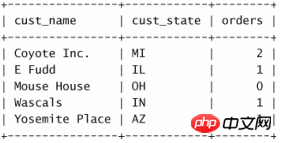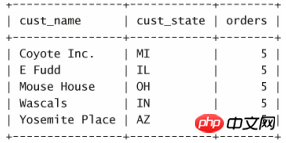Tutorial on creating calculated fields using subqueries in mysql
Using subqueries as calculated fields
Another way to use subqueries is to create calculated fields. Suppose you need to display the total number of orders for each customer in the customers table. Orders are stored in the orders table with corresponding customer IDs.
In order to perform this operation, follow the steps below.
(1) Retrieve the customer list from the customers table.
(2) For each retrieved customer, count the number of orders in the orders table.
As mentioned in the previous two chapters, you can use SELECT COUNT (*) to count the rows in the table, and by providing a WHERE clause to filter for a specific customer ID, you can filter only for that customer Orders are counted. For example, the following code counts orders for customer 10001:
Input:
select count(*) as orders from orders where cust_id = 10001;
To perform a COUNT(*) calculation for each customer, COUNT(*) should be used as a subquery . Please look at the following code:
Input:
select cust_name,cust_state,(select count(*) from orders where orders.cust_id = customers.cust_id) as orders from customers order by cust_name;
Output:

where orders.cust_id = customers.cust_id
select cust_name,cust_state,(select count(*) from orders where cust_id = cust_id) as orders from customers order by cust_name;

More than one solution As stated earlier in this chapter, although the sample code given here works well, it is not the most efficient way to solve this kind of data retrieval. We will encounter this example again in later chapters.
Build a query by gradually adding subqueries. Testing and debugging queries with subqueries can be tricky, especially as the complexity of these statements increases. The most reliable way to build (and test) a query with subqueries is to do it incrementally, much the same way MySQL handles them. First, build and test the innermost query. Then, build and test the outer query with hard-coded data, and only embed the subquery after confirming that it works. At this point, test it again. Repeat these steps for each query you want to add. Doing this adds only a small amount of time to constructing the query, but saves a lot of time later (finding out why the query is not working) and greatly increases the likelihood that the query will work properly in the first place.
[Related recommendations]
1. What is a mysql subquery? How to filter using subqueries?
2.What are connection and relationship tables in mysql?
3. Why use joins and how to create joins
4.The importance of WHERE clause in MySQL and how to join multiple tables
The above is the detailed content of Tutorial on creating calculated fields using subqueries in mysql. For more information, please follow other related articles on the PHP Chinese website!

Hot AI Tools

Undresser.AI Undress
AI-powered app for creating realistic nude photos

AI Clothes Remover
Online AI tool for removing clothes from photos.

Undress AI Tool
Undress images for free

Clothoff.io
AI clothes remover

AI Hentai Generator
Generate AI Hentai for free.

Hot Article

Hot Tools

Notepad++7.3.1
Easy-to-use and free code editor

SublimeText3 Chinese version
Chinese version, very easy to use

Zend Studio 13.0.1
Powerful PHP integrated development environment

Dreamweaver CS6
Visual web development tools

SublimeText3 Mac version
God-level code editing software (SublimeText3)

Hot Topics
 1379
1379
 52
52
 MySQL: Simple Concepts for Easy Learning
Apr 10, 2025 am 09:29 AM
MySQL: Simple Concepts for Easy Learning
Apr 10, 2025 am 09:29 AM
MySQL is an open source relational database management system. 1) Create database and tables: Use the CREATEDATABASE and CREATETABLE commands. 2) Basic operations: INSERT, UPDATE, DELETE and SELECT. 3) Advanced operations: JOIN, subquery and transaction processing. 4) Debugging skills: Check syntax, data type and permissions. 5) Optimization suggestions: Use indexes, avoid SELECT* and use transactions.
 How to open phpmyadmin
Apr 10, 2025 pm 10:51 PM
How to open phpmyadmin
Apr 10, 2025 pm 10:51 PM
You can open phpMyAdmin through the following steps: 1. Log in to the website control panel; 2. Find and click the phpMyAdmin icon; 3. Enter MySQL credentials; 4. Click "Login".
 How to create navicat premium
Apr 09, 2025 am 07:09 AM
How to create navicat premium
Apr 09, 2025 am 07:09 AM
Create a database using Navicat Premium: Connect to the database server and enter the connection parameters. Right-click on the server and select Create Database. Enter the name of the new database and the specified character set and collation. Connect to the new database and create the table in the Object Browser. Right-click on the table and select Insert Data to insert the data.
 MySQL: An Introduction to the World's Most Popular Database
Apr 12, 2025 am 12:18 AM
MySQL: An Introduction to the World's Most Popular Database
Apr 12, 2025 am 12:18 AM
MySQL is an open source relational database management system, mainly used to store and retrieve data quickly and reliably. Its working principle includes client requests, query resolution, execution of queries and return results. Examples of usage include creating tables, inserting and querying data, and advanced features such as JOIN operations. Common errors involve SQL syntax, data types, and permissions, and optimization suggestions include the use of indexes, optimized queries, and partitioning of tables.
 How to create a new connection to mysql in navicat
Apr 09, 2025 am 07:21 AM
How to create a new connection to mysql in navicat
Apr 09, 2025 am 07:21 AM
You can create a new MySQL connection in Navicat by following the steps: Open the application and select New Connection (Ctrl N). Select "MySQL" as the connection type. Enter the hostname/IP address, port, username, and password. (Optional) Configure advanced options. Save the connection and enter the connection name.
 Why Use MySQL? Benefits and Advantages
Apr 12, 2025 am 12:17 AM
Why Use MySQL? Benefits and Advantages
Apr 12, 2025 am 12:17 AM
MySQL is chosen for its performance, reliability, ease of use, and community support. 1.MySQL provides efficient data storage and retrieval functions, supporting multiple data types and advanced query operations. 2. Adopt client-server architecture and multiple storage engines to support transaction and query optimization. 3. Easy to use, supports a variety of operating systems and programming languages. 4. Have strong community support and provide rich resources and solutions.
 How to use single threaded redis
Apr 10, 2025 pm 07:12 PM
How to use single threaded redis
Apr 10, 2025 pm 07:12 PM
Redis uses a single threaded architecture to provide high performance, simplicity, and consistency. It utilizes I/O multiplexing, event loops, non-blocking I/O, and shared memory to improve concurrency, but with limitations of concurrency limitations, single point of failure, and unsuitable for write-intensive workloads.
 MySQL and SQL: Essential Skills for Developers
Apr 10, 2025 am 09:30 AM
MySQL and SQL: Essential Skills for Developers
Apr 10, 2025 am 09:30 AM
MySQL and SQL are essential skills for developers. 1.MySQL is an open source relational database management system, and SQL is the standard language used to manage and operate databases. 2.MySQL supports multiple storage engines through efficient data storage and retrieval functions, and SQL completes complex data operations through simple statements. 3. Examples of usage include basic queries and advanced queries, such as filtering and sorting by condition. 4. Common errors include syntax errors and performance issues, which can be optimized by checking SQL statements and using EXPLAIN commands. 5. Performance optimization techniques include using indexes, avoiding full table scanning, optimizing JOIN operations and improving code readability.




